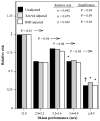Incident diverticular disease is inversely related to vigorous physical activity
- PMID: 19346983
- PMCID: PMC2831405
- DOI: 10.1249/MSS.0b013e318192d02d
Incident diverticular disease is inversely related to vigorous physical activity
Abstract
Purpose: In 1995, the Health Professionals Follow-up Study published an isolated report of lower diverticular disease risk in physically active men, particularly among those who ran. The purpose of this article was to assess whether this finding can be verified among older men and women of the National Runners' Health Study.
Methods: Survival analyses were applied to incident disease occurring during 7.7 yr of follow-up in 9072 men and 1664 women, representing 84% follow-up of the original >or=50-yr-old cohort. In addition to the usual running distance (km x d(-1)), 80% of the baseline respondents included 10-km footrace performance times (a measure of cardiorespiratory fitness). Results were adjusted for age, sex, and reported intakes of meat, fish, fruit, and alcohol.
Results: A total of 127 men and 21 women reported clinically diagnosed diverticular disease since baseline. The risk for incident diverticular disease decreased 6.2% per km x d(-1) run (P = 0.04). Relative to men and women who ran <or=2 km x d(-1), those who ran an average of >8 km x d(-1) had 48% lower risk (P = 0.05). Each meter-per-second increment in the 10-km performance was associated with a 68% risk reduction (P = 0.04). Men and women who ran >4 m x s(-1) had 70% lower risk for diverticular disease than those who ran <or=2.8 m x s(-1) (P = 0.01), which persisted when adjusted for baseline body mass index (69% risk reduction, P = 0.02) or usual running distance (36% risk reduction, P = 0.03).
Conclusion: These results demonstrate an inverse association between vigorous physical activity and incident diverticular disease among older men and women but are limited by their reliance on self-reported physician diagnosis.
Figures


References
-
- Ainsworth BE, Haskell WL, Whitt MC, et al. Compendium of physical activities: an update of activity codes and MET intensities. Med Sci Sports Exerc. 2000;32(9 suppl):S498–S516. - PubMed
-
- Aldoori WH, Giovannucci EL, Rimm EB, Wing AL, Trichopoulos DV, Willett WC. A prospective study of diet and the risk of symptomatic diverticular disease in men. Am J Clin Nutr. 1994;60:757–64. - PubMed
-
- Aldoori WH, Giovannucci EL, Rimm EB, Wing AL, Trichopoulos DV, Willett WC. A prospective study of alcohol, smoking, caffeine, and the risk of symptomatic diverticular disease in men. Ann Epidemiol. 1995;5:221–8. - PubMed
-
- Aldoori WH, Willett WC. Reply, Diverticular distraction. Gut. 1995;37:299.
Publication types
MeSH terms
Grants and funding
LinkOut - more resources
Full Text Sources
Medical
Miscellaneous

